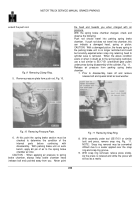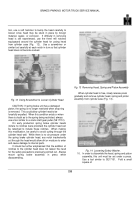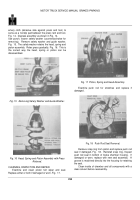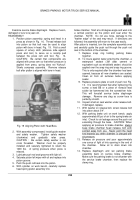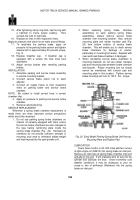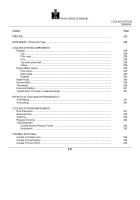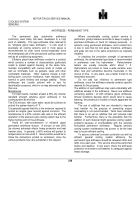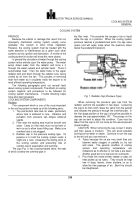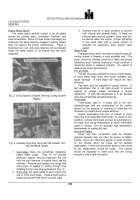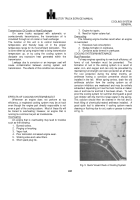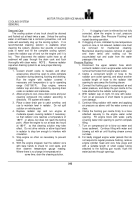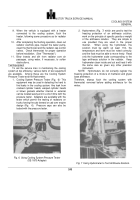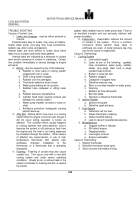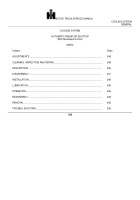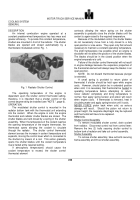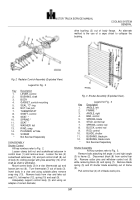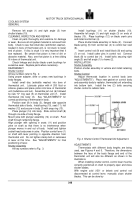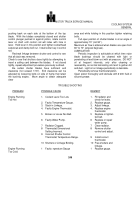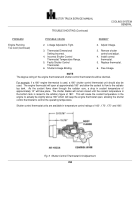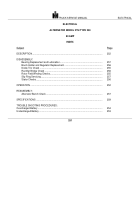TM-5-3805-254-14-P-2 - Page 246 of 894
MOTOR TRUCK SERVICE MANUAL
COOLING SYSTEM
GENERAL
Seasonal Care
The cooling system of any truck should be drained
and flushed out at least twice a year.
Unless the cooling
water or antifreeze has a corrosion preventive, rust and
scale will eventually clog up the cooling system.
If no
recommended cleaning solution is available when
cleaning the system, dissolve four pounds of washing
soda in water and fill the complete cooling system.
Leave the radiator cap off and run the engine until it is
hot.
Then disconnect the radiator outlet hose so all
sediment will pass through the drain cock and flush
thoroughly with clean water.
NOTE :
Remove radiator
cap when draining system to as sure proper draining.
Cleaning
1. Coolant shutoff cocks to heaters and other
accessories should be open to allow complete
circulation during cleaning, flushing and draining.
Run the engine with radiator covered if
necessary until temperature is up to operating
range (160°180°F).
Stop engine, remove
radiator cap and drain system by opening drain
cocks on radiator and crankcase.
2. Allow engine to cool, close drain cocks and pour
cleaning compound into radiator according to
directions.
Fill system with water.
3. Place a clean drain pan to catch overflow, and
use to maintain level in radiator.
Do not spill
solution on vehicle paint.
4. Replace radiator cap and run engine at
moderate speed, covering radiator if necessary,
so that radiator core reaches a temperature of
180°F.
or above, but does not reach the boiling
point.
Allow the engine to run at least two hours
at 180°F.
so that cleaning solution may take
effect.
Do not drive vehicle or allow liquid level
in radiator to drop low enough to interfere with
circulation.
5. Stop engine as often as necessary to prevent
boiling.
6. With the engine stopped, feel the radiator core
with bare hands to check for cold spots, and
then observe temperature gauge reading.
Where there is no change in temperature for
some time, drain the cleaning solution.
7.
If clogging of core is relieved but not fully
corrected, allow the engine to cool, pressure
flush the system (See Pressure Flushing) and
repeat cleaning operation.
8. If clogging of core, indicated by low temperature
spots on core, is not relieved, radiator core must
be
removed
for
mechanical
cleaning.
Mechanical cleaning requires removal of upper
and
lower
tanks
and
rodding
out
the
accumulated rust and scale from the water
passage of the core.
Pressure Flushing
1. Disconnect the upper radiator hose which
connects radiator core to engine water outlet and
remove thermostat from engine water outlet.
2. Clamp a convenient length of hose to the
radiator core outlet opening, and attach another
suitable length of hose to the radiator inlet
opening to carry away the flushing stream.
3. Connect the flushing gun to compressed air and
water pressure, and clamp the gun nozzle to the
hose attached to the radiator outlet opening.
4. With radiator cap on tight, fill core with water.
Turn on air pressure in short blasts to prevent
core damage.
5. Continue filling radiator with water and applying
air pressure as above until the water comes out
clear.
6. Clamp the flushing gun nozzle firmly to a hose
attached securely to the engine water outlet
opening.
Fill engine block with water, partly
covering water inlet opening to permit complete
filling.
7. Turn on compressed air to blow out water and
loose sediment.
Continue filling with water and
blowing out with air until flushing stream comes
out clear.
8. For badly clogged engine water jackets that do
not respond to regular pressure flushing, remove
engine cylinder head and core hole plugs and
with a suitable length of small copper tubing
attached to the flushing gun nozzle, flush the
water jackets through openings.
242
Back to Top

